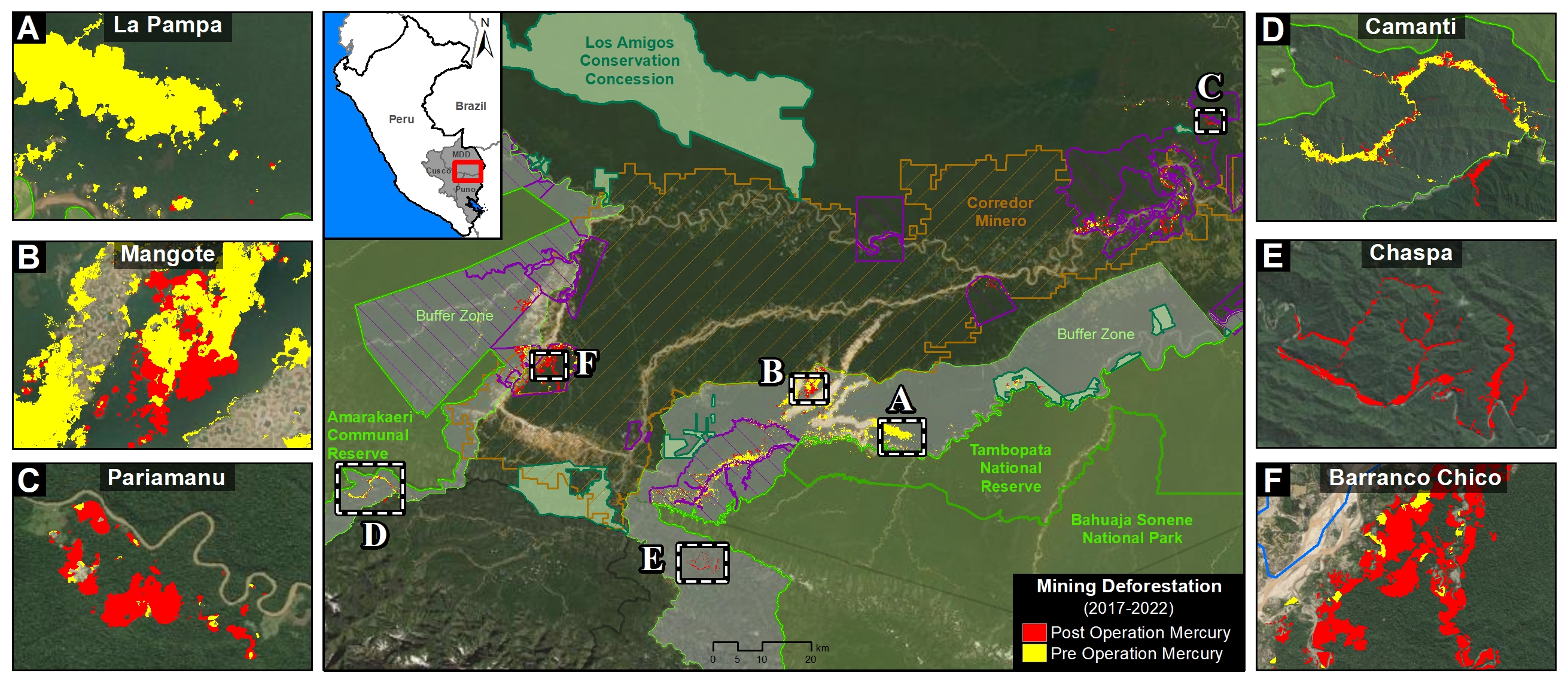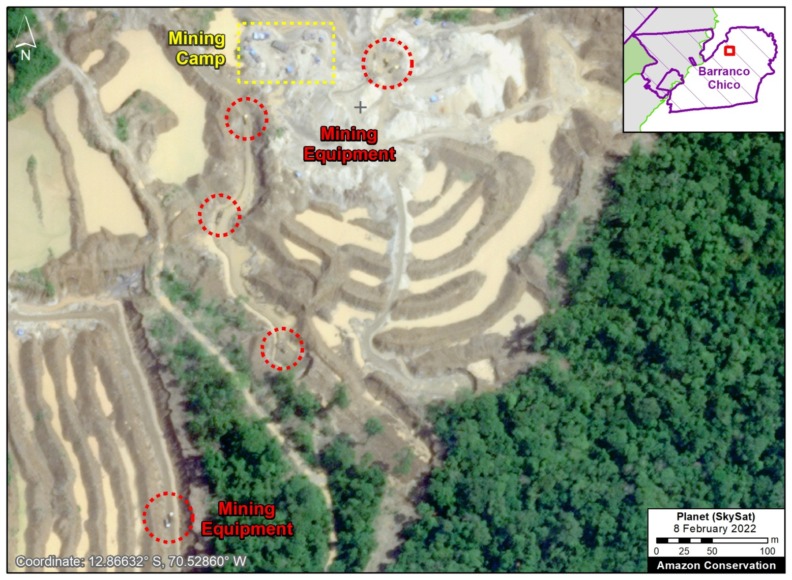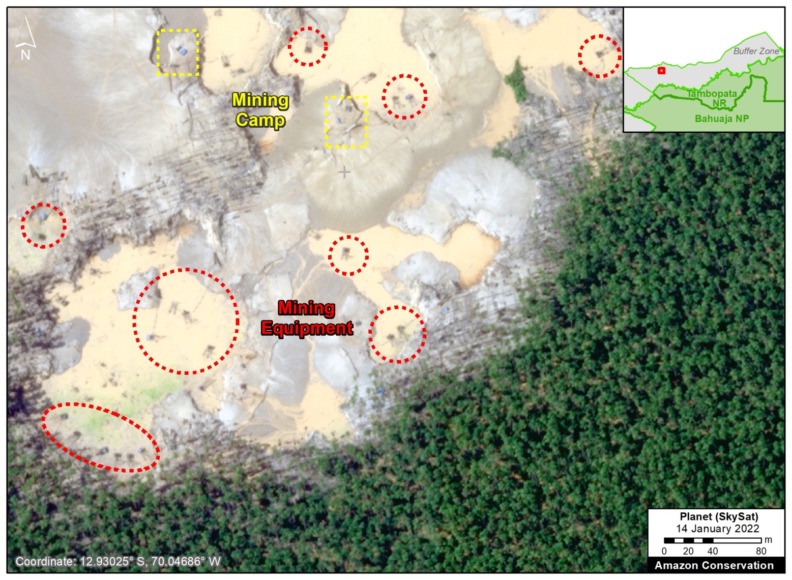
MAAP #154: Illegal Gold Mining in the Peruvian Amazon – 2022 update
May 22, 2022

Illegal gold mining reached crisis levels in the southern Peruvian Amazon in 2017 and 2018, clearing over 1,200 hectares (3,000 acres) in the most critically impacted area, known as La Pampa (located in the buffer zone of Tambopata National Reserve, region of Madre de Dios).
In early 2019, the Peruvian government launched Operation Mercury, an unprecedented long-term crackdown on illegal mining, with an initial focus in La Pampa.
Here, we present an updated analysis of illegal gold mining in the Peruvian Amazon. Specifically, we compare rates of deforestation before vs after Operation Mercury at the most important illegal mining sites (see Base Map).
We found that illegal gold mining deforestation decreased 62% overall across all sites following Operation Mercury, including a remarkable 96% decrease in La Pampa.
However, illegal mining deforestation has increased at several key sites, most notably indigenous territories.
Results: Base Map
The Results Map below illustrates the major findings. Red indicates gold mining deforestation post-Operation Mercury (3,688 hectares between March 2019 and December 2021), while yellow indicates the pre Operation baseline (6,933 hectares between January 2017 and February 2019).
Note that deforestation in the most critical illegal mining front, La Pampa (Tambopata National Reserve buffer zone), has essentially been stopped. However, mining continues in other key areas such as Mangote, Pariamanu, Camanti (Amarakaeri Commuanl Reserve buffer zone), Chaspa (Bahuaja Sonene National Park buffer zone), leading to new government interventions in each of these areas.
Regarding Native Communities, the most impacted after Operation Mercury include Barranco Chico (1,098 hectares), Tres Islas (503 hectares), Puerto Luz (136 hectares), and Kotsimba (inside the Alto Malinowski area; 518 hectares). The government has recently conducted two raids in Barranco Chico, indicating they are aware of this situation.

Results: Graph
The Results Graph below further details the major findings:
- Overall, gold mining deforestation decreased 62% across all sites following Operation Mercury (from 279 to 105 hectares per month).
h - Most notably, mining deforestation decreased 96% in La Pampa, the most critically impacted area (from 149 to 6.5 hectares per month).
j - Mining deforestation decreased 81% in the other sites within the buffer zones of key protected area (Tambopata National Reserve, Bahuaja Sonene National Park, and Amarakaeri Communal Reserve).
j - Mining deforestation increased 100% in two new critical fronts, Pariamanu and Chaspa.
g - Mining deforestation increased 128% in the four Native Communities (Barranco Chico, Boca Inambari, Tres Islas, and Puerto Luz).
Very High Resolution Satellite Imagery (Skysat)
Below, we show a striking series of recent (January to March 2022) and very high resolution (0.5 meter Skysat) images of three primary current illegal mining sites: Barranco Chico, Pariamanu and Mangote. These images reveal machinery and infrastructure (indicated by red circles) as well as camps (indicated by yellow squares) directly associated with illegal gold mining activity.
Native Community Barranco Chico
Pariamanu
Mangote
Methodology
We analyzed high-resolution imagery (3 meters) from the satellite company Planet obtained from their interface Planet Explorer. Based on this imagery, we digitized gold mining deforestation across ten major sites: La Pampa, Mangote, Alto Malinowski, Camanti, Pariamanu/Pariamarca, Apaylon, Chaspa, Barranco Chico, and Boca Inambari. These were identified as the major active illegal gold mining deforestation fronts based on analysis of automated forest loss alerts generated by University of Maryland (GLAD alerts) and the Peruvian government (Geobosques) and additional land use layers. The area referred to as the “mining corridor” is not included in the analysis because the issue of legality is more complex.
Across these sites, we identified, digitized, and analyzed all visible gold mining deforestation between January 2017 and the present (December 2021). We defined before Operation Mercury as data from January 2017 to February 2019, and after Operation Mercury as data from March 2019 to the present. Given that the former was 26 months and the latter 32 months, during the analysis the data was standardized as gold mining deforestation per month.
The data is updated through December 2021.
Acknowledgments
We thank O. Liao, S. Otoya, J. Guerra, K. Nielsen, S. Novoa, M.E. Gutierrez, Z. Romero, and G. Palacios for their helpful comments on this report.
This report was conducted with technical assistance from USAID, via the Prevent project. Prevent works with the Government of Peru, civil society and the private sector to prevent and combat environmental crimes for the sake of the conservation of the Peruvian Amazon, particularly in the regions of Loreto, Madre de Dios and Ucayali.
This publication is made possible with the support of the American people through USAID. Its content is the sole responsibility of the authors and does not necessarily reflect the views of USAID or the US government.
Citation
Finer M, Mamani N, Spore J (2021) Peruvian Amazon Illegal Gold Mining update. MAAP: #154.





























